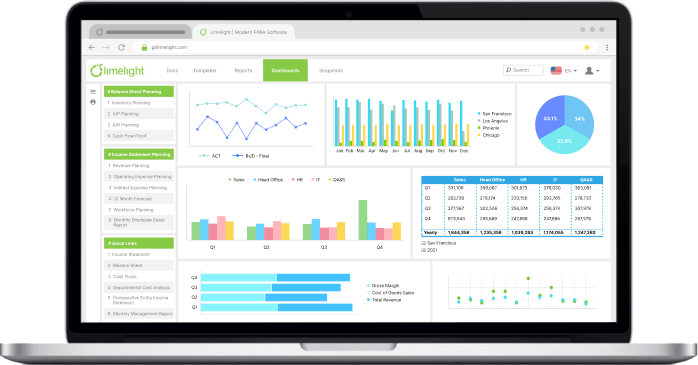FP&A Machine Learning - the Current State of AI in FP&A
By Thomas Sword |
Published: August 28, 2023
By Thomas Sword |
Published: August 28, 2023
FP&A machine learning is ready to help you unlock your full potential as CFO.
In fact, few roles are set to be revolutionized the way AI is going to transform the CFO role - turning you into the finance rockstar you always could be, but were too bogged down in rote manual tasks and spreadsheet jockeying. That’s good news - better news is that you don’t have to wait to start taking advantage of AI’s promise. That’s where FP&A machine learning comes in.
Let’s explore what machine learning in FP&A even means - and how you can leverage it to do more, faster.
Machine learning is a subset of AI designed to mimic human learning by using data and algorithms to recognize patterns. Over time, the algorithm becomes smarter and more accurate, thus the ‘learning’ element.
AI is a broader concept that refers to the simulation of human intelligence in machines, enabling them to perform tasks that typically require human intelligence - think problem-solving, reasoning, learning, and decision-making.
In other words, ML is a branch of AI that specifically deals with the development of algorithms and models that enable computers to learn from data and improve their performance on a specific task over time without being explicitly programmed to do so.
Experts at UC Berkeley break ML down into three components:
As a CFO, you’re dealing with huge volumes of data. Budgets, reports, forecasts . . . before long you’re buried in a deluge of numbers and spreadsheets and tables. Trying to analyze all this data in a timely fashion is impossible - for humans. But machine learning in finance can analyze these huge datasets and produce a variety of useful insights, including:
These are hugely beneficial insights that can turn you as the CFO into one of the biggest value drivers at your organization.
And it goes without saying that all these tasks will be automated by the AI, so you have more time to analyze and parse out these insights, in addition to making connections of your own that the machine might have missed. That’s the beauty of it - AI and CFO working in tandem to provide real value to your business.
FP&A activities have long benefited from platforms and other tools, making it faster, more accurate, and more robust. Machine learning in FP&A is simply the next technological leap. CFOs, in other words, can level up their productivity with ease when they being leveraging AI for FP&A.
We mentioned that ML analyzes huge sets of data that in turn can greatly enhance your FP&A processes - here’s how it works.
ML algorithms leverage historical financial and operational data, analyzing complex datasets, identifying patterns, and generating forecasts with greater accuracy and efficiency than traditional methods.
For example, ML can be applied to:
With FP&A machine learning, you’ll be empowered to do more.
‘More’ meaning:
Since the beginning of the digital age, FP&A teams have been using computers to help mitigate the number of repetitive tasks they have to undertake. Data entry and transference are FP&A processes that can be time consuming when done manually - not to mention are prone to human errors and oversights. Machine learning automates the process and continues to self-improve, so you only ever get faster and more accurate, giving you your time back to do more in-depth and growth-driving analysis.
|
Learn more about FP&A software:
|
Your ML algorithm will analyze historical financial and operational data to create predictive models, streamline forecasting processes, and generate real-time insights. Additionally, it automates data collection, cleansing, and analysis. The end result is more accurate modeling, scenario planning, and risk assessment. ML is also fantastic at detecting anomalies in your data you may miss. And while it’s looking through your data for anomalies, it can also detect trends which can inform future resource allocation so you can ensure your teams have everything they need to succeed.
Machine learning enhances one of the most critical elements of FP&A - trend prediction - by analyzing huge swaths of data to help determine future trends/identify opportunities.
Programs for machine learning in FP&A will analyze past financial performances, identifying key drivers of success that can then be replicated in future quarters. Furthermore, it can be relied upon to generate more accurate budget projections.
Financial forecasts can only be valuable if they’re accurate. Machine learning algorithms will analyze historical financial data in order to determine patterns that people otherwise may miss. Couple this with the speed algorithms have with identifying patterns, and you can expedite the forecasting process and in turn enable rolling forecasts.
Machine learning applications are adept, as we’ve covered, at finding patterns hidden within gigabytes, maybe even terabytes of data. That includes the ability to find aberrations in your financial data, like transactions or patterns that stick out, which can in turn help identify errors.
Artificial intelligence and machine learning are there to help your finance team not only determine what happened, but why it happened. The ability to recognize patterns and learn from them enhances the ability of AI to identify the root causes of these patterns, empowering you to take appropriate actions - whether that’s replicating the actions that produced positive results, or alter actions that produced negative outcomes.
AI promises to revolutionize our work. FP&A deals with large volumes of hard data and therefore it is uniquely suited to benefit from the support AI provides.
The future is bright, certainly, but you can benefit today in real time by leveraging machine learning in FP&A.
Limelight Cloud FP&A Software features FP&A machine learning, so you can get a taste of the future in the present.
Discover how we've transformed the landscape of FP&A through our case studies, showing how businesses are already benefiting from our approach
Subscribe to our newsletter


